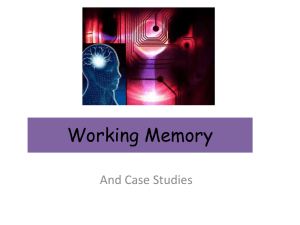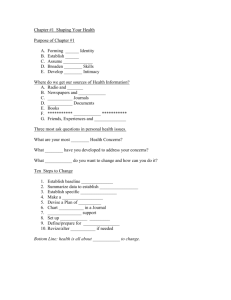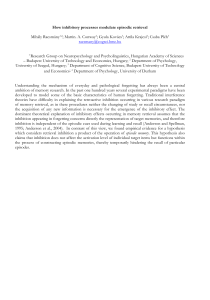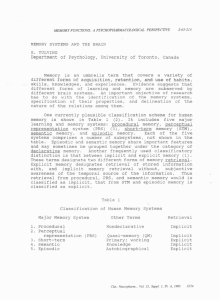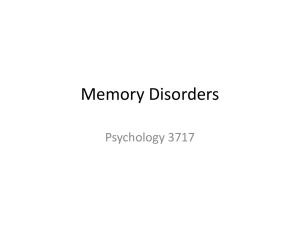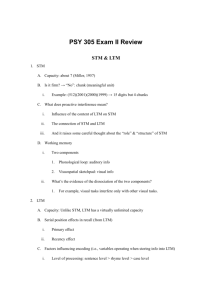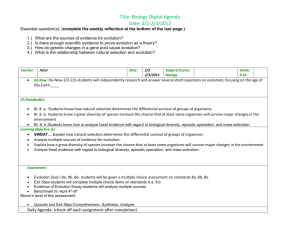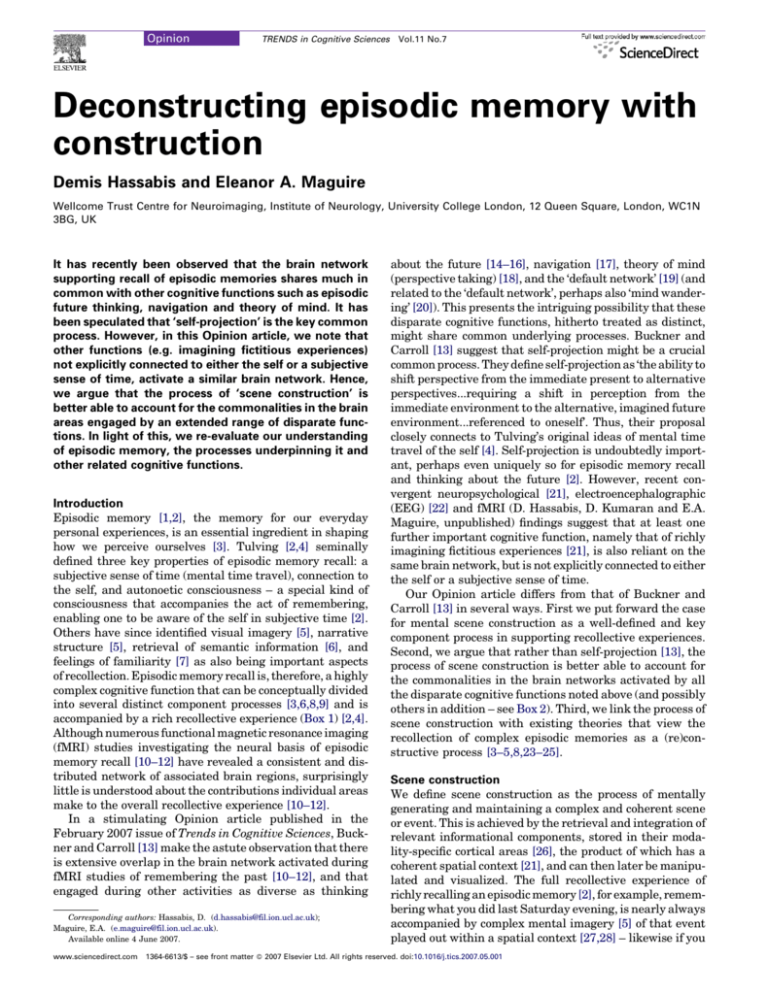
Opinion
TRENDS in Cognitive Sciences
Vol.11 No.7
Deconstructing episodic memory with
construction
Demis Hassabis and Eleanor A. Maguire
Wellcome Trust Centre for Neuroimaging, Institute of Neurology, University College London, 12 Queen Square, London, WC1N
3BG, UK
It has recently been observed that the brain network
supporting recall of episodic memories shares much in
common with other cognitive functions such as episodic
future thinking, navigation and theory of mind. It has
been speculated that ‘self-projection’ is the key common
process. However, in this Opinion article, we note that
other functions (e.g. imagining fictitious experiences)
not explicitly connected to either the self or a subjective
sense of time, activate a similar brain network. Hence,
we argue that the process of ‘scene construction’ is
better able to account for the commonalities in the brain
areas engaged by an extended range of disparate functions. In light of this, we re-evaluate our understanding
of episodic memory, the processes underpinning it and
other related cognitive functions.
Introduction
Episodic memory [1,2], the memory for our everyday
personal experiences, is an essential ingredient in shaping
how we perceive ourselves [3]. Tulving [2,4] seminally
defined three key properties of episodic memory recall: a
subjective sense of time (mental time travel), connection to
the self, and autonoetic consciousness – a special kind of
consciousness that accompanies the act of remembering,
enabling one to be aware of the self in subjective time [2].
Others have since identified visual imagery [5], narrative
structure [5], retrieval of semantic information [6], and
feelings of familiarity [7] as also being important aspects
of recollection. Episodic memory recall is, therefore, a highly
complex cognitive function that can be conceptually divided
into several distinct component processes [3,6,8,9] and is
accompanied by a rich recollective experience (Box 1) [2,4].
Although numerous functional magnetic resonance imaging
(fMRI) studies investigating the neural basis of episodic
memory recall [10–12] have revealed a consistent and distributed network of associated brain regions, surprisingly
little is understood about the contributions individual areas
make to the overall recollective experience [10–12].
In a stimulating Opinion article published in the
February 2007 issue of Trends in Cognitive Sciences, Buckner and Carroll [13] make the astute observation that there
is extensive overlap in the brain network activated during
fMRI studies of remembering the past [10–12], and that
engaged during other activities as diverse as thinking
Corresponding authors: Hassabis, D. (d.hassabis@fil.ion.ucl.ac.uk);
Maguire, E.A. (e.maguire@fil.ion.ucl.ac.uk).
Available online 4 June 2007.
www.sciencedirect.com
about the future [14–16], navigation [17], theory of mind
(perspective taking) [18], and the ‘default network’ [19] (and
related to the ‘default network’, perhaps also ‘mind wandering’ [20]). This presents the intriguing possibility that these
disparate cognitive functions, hitherto treated as distinct,
might share common underlying processes. Buckner and
Carroll [13] suggest that self-projection might be a crucial
common process. They define self-projection as ‘the ability to
shift perspective from the immediate present to alternative
perspectives...requiring a shift in perception from the
immediate environment to the alternative, imagined future
environment...referenced to oneself’. Thus, their proposal
closely connects to Tulving’s original ideas of mental time
travel of the self [4]. Self-projection is undoubtedly important, perhaps even uniquely so for episodic memory recall
and thinking about the future [2]. However, recent convergent neuropsychological [21], electroencephalographic
(EEG) [22] and fMRI (D. Hassabis, D. Kumaran and E.A.
Maguire, unpublished) findings suggest that at least one
further important cognitive function, namely that of richly
imagining fictitious experiences [21], is also reliant on the
same brain network, but is not explicitly connected to either
the self or a subjective sense of time.
Our Opinion article differs from that of Buckner and
Carroll [13] in several ways. First we put forward the case
for mental scene construction as a well-defined and key
component process in supporting recollective experiences.
Second, we argue that rather than self-projection [13], the
process of scene construction is better able to account for
the commonalities in the brain networks activated by all
the disparate cognitive functions noted above (and possibly
others in addition – see Box 2). Third, we link the process of
scene construction with existing theories that view the
recollection of complex episodic memories as a (re)constructive process [3–5,8,23–25].
Scene construction
We define scene construction as the process of mentally
generating and maintaining a complex and coherent scene
or event. This is achieved by the retrieval and integration of
relevant informational components, stored in their modality-specific cortical areas [26], the product of which has a
coherent spatial context [21], and can then later be manipulated and visualized. The full recollective experience of
richly recalling an episodic memory [2], for example, remembering what you did last Saturday evening, is nearly always
accompanied by complex mental imagery [5] of that event
played out within a spatial context [27,28] – likewise if you
1364-6613/$ – see front matter ß 2007 Elsevier Ltd. All rights reserved. doi:10.1016/j.tics.2007.05.001
300
Opinion
TRENDS in Cognitive Sciences
Box 1. What, where, when – are they equally important?
In the classic taxonomy of episodic memory [1,2], what, where and
when, have been traditionally regarded as equally important
properties of an episodic memory [2,4]. Indeed, a memory of an
event is only defined as truly episodic if one remembers when and
where it happened in addition to what happened [2]. The rich
recollective experience that accompanies the recall of an episodic
memory [2,4] has content and a spatial context, the what and the
where – the central contribution of the scene construction process to
the provision of this coherent spatial context has been highlighted
in the main text. But what role does time have, and is it really as
important to the recollective experience as the other two aspects of
an episodic memory? Much has been written about time [2,75–78]
and there are at least two types of time that have relevance to the
recollective experience of episodic memory. There is the moment by
moment order in which an event or sequence unfolds [72] or ‘microtime’. Then there is subjective time [2], the timeline against which
the events in our lives play out, the conscious awareness of which
has been dubbed chronesthesia [76], and which we view as ‘macrotime’. Micro-time, then, is an intrinsic property of an episodic
memory that when recalled ensures it is played back in the same (or
reverse [79]) temporal sequence in which it was recorded [43]. It is
related to the physical laws of nature, for example, one must open a
door before going through it, and it might be reliant on the special
anatomical properties of the hippocampus [43,44].
By contrast, macro-time is a concept that, unlike micro-time [72],
perhaps only humans possess [2,73]. But should it be elevated to the
status of a special sense or process as some have suggested [13,76],
and is it necessary for the full recollective experience of an episodic
memory? Recent empirical evidence does not support the idea that
chronesthesia is an independent process with a distinct neural
signature. Near total overlap has been found in brain regions
supporting past episodic memory recall and episodic future thinking
[15,16]. Besides the subjective sense of past/future as described by
Tulving [4], macro-time has also been commonly interpreted to
mean that there are specific time-tags associated with each episodic
memory. Interestingly, studies testing memories from distinct time
periods have also failed to show consistent neural correlations in
response to macro-time modulation [15,41,51,80,81], and time is
also a poor retrieval cue for episodic memory [82]. Finally, if the age
of a memory has some intrinsic neural basis then it seems plausible
it might be related to the age of its memory trace [41,83]. However,
in light of current ideas regarding reconsolidation [84], it is not clear
whether one can meaningfully talk about the age of a memory
because the act of recalling it refreshes the trace anew [84].
Thus, although macro or subjective time is frequently part of a
true episodic memory it is not clear whether it can be meaningfully
separated from ideas of the self and autonoetic consciousness [2].
This is in contrast to micro-time, which appears to be an intrinsic
property of an episodic memory [43,79]. By this view then, the
timestamp of an event simply becomes another piece of semantic
knowledge that might or might not be retrieved or logically deduced
at the point the event is recalled, perhaps not too dissimilar to the
name of the place it occurred in or the names of any people
involved.
cast your mind forwards to what you might be doing next
Saturday evening [14]. However, we believe that scene
construction is not just limited to remembering the past
[2] or thinking about the future [14]. For example, nowhere
is it more necessary than for navigation [29]. Think about
how you would get to your favourite restaurant and chances
are you will construct a mental representation of the street,
the surrounding vicinity, and perhaps where you might
park. Alternatively, imagine taking a pleasant walk through
a forest that you have never been to, seen, or recognize but is
instead purely a product of your imagination. Again, construction of a coherent scene would appear to be integral to
the process of vividly imagining such a fictitious experience
www.sciencedirect.com
Vol.11 No.7
[21]. Thus, we argue that the cognitive functions outlined in
Box 2 are related because they all crucially rely on scene
construction as a common core process, and that this can
account for a large proportion of the overlapping network
found in neuroimaging studies of these functions [13]. If
scene construction is a key underlying component process
of episodic memory, this would accord well with theories of
memory that propose the recollection of complex episodic
memories is actually a (re)constructive process [3–5,8,23–
25] as opposed to the all-or-nothing retrieval of a perfect
‘holistic’ record often implicitly assumed (e.g. Ref. [30]; also
see discussions in Refs [31,32]). Indeed, well-known memory
errors and inconsistencies [33,34], such as misattribution
[33], provide further tacit evidence for constructivist views of
episodic memory [3–5,8,23–25].
Neuropsychological evidence
So which brain regions might support scene construction
and what are their roles? Neuropsychological studies of
patients with hippocampal damage confirm that the hippocampus is crucial for episodic memory [35,36] and navigation [37]. It has also been demonstrated that hippocampal
damage [21,38–40] is associated with an impairment in
thinking about one’s personal future [14]. However, a recent
study [21] showed that the deficit might not be limited to just
past and future personal experiences as some have suggested [13,15,40], but possibly to any task that requires a
rich ‘recollection-like’ experience [21]. Hassabis et al. [21]
devised a novel paradigm where participants, rather than
recollecting the past, had to construct new imagined experiences in response to short verbal cues that outlined a range
of simple commonplace scenarios. In all previous studies
and discussions [13], it is assumed that imagination necessarily involves mental time travel involving the self into the
future, and is a form of episodic future thinking [14]. By
contrast, Hassabis et al. do not make such an assumption,
and maintain that it is possible to richly imagine and
visualize a new fictitious experience that is not explicitly
temporal in nature, and that is not necessarily self-relevant,
plausible or even possible (Box 2). They found that amnesic
patients with bilateral hippocampal damage were markedly
impaired relative to matched control subjects at imagining
new fictitious experiences (Figure 1). Moreover, Hassabis
et al. [21] identified a possible source for this deficit.
Although patients were able to produce considerable detail
when asked to imagine fictitious new experiences, their
descriptions lacked spatial coherence and were instead
fragmented and considerably less rich [21].
We believe these findings provide empirical evidence that
the hippocampus supports scene construction, crucial for
imagining new experiences (and we would argue for recollecting the past, imagining the future and navigation; Box
2), either through its ability to process spatial information
[27,28,41,42] or bind together disparate elements of the
imagined scene [43–46]. These findings could also have
implications for the ongoing debate [47] concerning whether
the hippocampus is necessary [41] or not [48] for supporting
remote episodic memories. It has been suggested that discrepancies between studies of remote episodic memory
in hippocampal patients [47] might be accounted for by
differences in the quality or richness of the recollective
Opinion
TRENDS in Cognitive Sciences
Vol.11 No.7
301
Box 2. Component processes
The intention here (Table I) is to summarize the mapping of the
component processes discussed in the main text onto a set of related
cognitive functions. It is not intended to be an exhaustive list of all
possible processes involved in these cognitive functions, nor are we
suggesting these are the only cognitive functions these processes are
involved in. Nonetheless we believe this provides a useful overview of
our argument.
Definitions of cognitive functions
Episodic memory recall – vivid recollection of a personal past event
[2].
Episodic future thinking – envisaging a plausible personal future
event [14].
Navigation – route planning and wayfinding [17].
Imagination – richly imagining and visualizing a new fictitious
experience [21] that is not explicitly temporal in nature and is not
necessarily self-relevant, plausible or even possible. Although it
might involve the adoption of an egocentric viewpoint [59] on the
part of the imaginer, a purely created imagined experience would
not have the same reliance or effect on the imaginer’s self-concept
[3] compared with a real episodic memory.
Default network – so-called default network activated when no overt
task is assigned [19], also suggested to be related to mind
wandering or daydreaming [20].
Viewer replay – the vivid replay of an episodic-like memory even
though the specific temporal time tag cannot be remembered, it has
only an internal spatial context and, as with imagination (see
above), does not explicitly involve the self or affect the viewer’s selfconcept. For example, the recollection of one’s favourite episode
from an old TV series can be vivid and detailed, even though often
one can no longer remember when or where it was seen. This type
of memory is of ambiguous theoretical status (because it only has
the ‘what’ [2]) and does not fit easily into definitions of episodic or
semantic memory [2].
Vivid dreaming – vivid visual dreaming usually takes place during
the rapid eye movement (REM) phase of sleep [85]. Interestingly,
global cessation of dreaming has been associated with damage to
either frontal or parietal cortex [85].
Theory of mind – modelling the mental states and intentions of
others [18].
Definitions of processes
Scene construction – includes the retrieval of relevant semantic and
sensory information [9,26], its integration into a coherent spatial
context [21] and online maintenance for later manipulation and
visualization [5] including possible viewpoint transformation [59].
Subjective time – sense of the self in the context of the timeline
against which the events in our lives play out [2] or chronesthesia
[76].
Self – processes reliant on or affecting the concept of oneself [3] and
thereby having a direct connection to or influence over our selfperception [2].
Autonoetic consciousness – a special kind of consciousness that
accompanies the act of remembering, allowing one to be aware of
the self in subjective time [2].
Narrative – a story structure formed by the unfolding of a sequence
of events [5].
Familiarity – a subjective feeling or judgement of oldness [7].
Visual imagery – complex visual imagery, involving the composition
of simple imagery such as single objects [5].
Prospective planning – making plans about how to achieve future
goals [61].
Task monitoring – executive processes overseeing successful
constructive task performance [61].
Table I. Mapping of component processes to cognitive functionsa
Episodic
memory recall
Episodic
future
thinking
Navigation
Imagination
Default
network
Viewer replay
Vivid
dreaming
Theory of
mind
Scene
construction
Y
Subjective
time
Y
Y
Self
Narrative
Familiarity
Y
Autonoetic
consciousness
Y
Y
Visual
imagery
Y
Prospective
planning
N
Task
monitoring
Y
Y
Y
Y
Y
Y
Y
Y
Y
Y
Y
Y
Y
N
N
N
D
N
Y
N
N
D
N
D
D
D
D
D
Y
Y
D
Y
N
N
Y
Y
U
Y
Y
N
N
N
D
N
N
Y
Y
Y
D
Y
Y
N
N
Y
U
D
N
Y
N
N
D
D
D
D
Abbreviations: Y, yes – process is involved in that cognitive function; N, no – process is not involved in that cognitive function; D, depends – process involvement depends
on the precise nature of the task and the content operated on; U, unknown – unclear if process is involved in that cognitive function.
a
Processes are labelled along the top and cognitive functions down the left hand side.
experience, a feature that is not always captured by existing
scoring systems [41,49,50]. Indeed, recent evidence suggests
that the hippocampus might be crucial for recollecting vivid,
detailed episodic memories, regardless of their age [41,51,
52]. Hassabis et al.’s results [21] are consistent with this
perspective and moreover suggest that the crucial attribute
determining whether internally generated experiences,
either real or imaginary, are hippocampal-dependent might
be the extent to which they are vividly (re-)experienced.
Neuroimaging evidence
The hippocampus, although apparently vital, does not
support scene construction on its own. In contrast to
www.sciencedirect.com
neuropsychological studies, fMRI permits examination of
distributed networks of brain regions engaged during
tasks. In addition, by using what is known as a conjunction
analysis, it is possible to ascertain the brain areas that are
engaged in common during the performance of different
tasks. Imagining fictitious experiences and reliving past
memories share many of the same psychological processes
[3,6,8,9] primarily related to scene construction [21]. We
recently investigated whether they had neural substrates
in common using fMRI (D. Hassabis, D. Kumaran and E.A.
Maguire, unpublished). During scanning, subjects were
asked to recall recent episodic memories. They also retrieved fictitious experiences previously constructed one
302
Opinion
TRENDS in Cognitive Sciences
Vol.11 No.7
Figure 1. The hippocampus and scene construction. Hassabis et al. [21] devised a novel paradigm where patients with bilateral hippocampal damage (see example patient
MRI scan in (a), with atrophied hippocampi circled) and matched control subjects, rather than recollecting the past, had to imagine fictitious experiences. Patients were
significantly impaired on this task. The mean scores (and standard errors) on the overall composite measure, the Experiential Index, are shown in (b). The findings also offer
some insight into a mechanism whose absence could underpin the deficit. Patients’ imagined experiences were strikingly deficient in spatial coherence (c), resulting in their
constructions being fragmented and lacking in richness.
week before, and in addition constructed new fictitious
experiences for the first time while in the scanner. A
conjunction analysis of the three conditions, which have
scene construction as their primary process in common,
revealed activation of a network of regions including, not
surprisingly, (compare with Ref. [21]) the hippocampus,
but also parahippocampal gyrus, retrosplenial cortex, and
posterior parietal cortex, as well as the ventromedial
prefrontal cortex (vmPFC, BA 12) and middle temporal
cortices (Figure 2). Previous fMRI studies have consistently
observed activation of a similar network during navigation
[17,53], spatial [54,55], place [56,57] and episodic memory
[10,11] tasks lending further credence to the notion of scene
construction as a common core process.
Figure 2. The extended brain network involved in scene construction. The common brain network that underlies the recall of episodic memories, recall of previously
imagined experiences, and the creation of new imagined experiences (D. Hassabis, D. Kumaran and E.A. Maguire, unpublished; also see main text). Sagittal (a) and axial
(b) images from a ‘glass brain’ – this enables one to appreciate activations in all locations and levels in the brain simultaneously. The glass brain reveals an extensive
temporo-parietal-frontal network including bilateral hippocampus, parahippocampal gyrus, retrosplenial and posterior parietal cortices, and ventromedial prefrontal cortex.
(c) Bilateral hippocampus activation on a coronal section of an averaged structural MRI scan.
www.sciencedirect.com
Opinion
TRENDS in Cognitive Sciences
Although relatively understudied, the retrosplenial
cortex [58] plays a major role in memory and navigation
[53]. Perhaps through facilitating viewpoint transformation
from an allocentric to egocentric framework [29,59] or by
acting as an output buffer to represent dynamically episodic
information [7,60] that has been retrieved and bound by the
hippocampus [21,43]. Moreover, retrosplenial cortex is
known to have major anatomical connections to vmPFC
[58], also activated in the conjunction analysis (Figure 2).
The vmPFC has been implicated in performance monitoring
[61] and semantic detail generation [15], both of which
would be required in scene construction, with the middle
temporal cortex activations probably reflecting the retrieval
of semantic information [62]. The vmPFC might therefore
work in concert with medial temporal lobe structures and
retrosplenial cortex to monitor successfully the scene construction process [61].
Other key properties of episodic memory
Scene construction can, therefore, account for a good deal of
the brain network consistently activated by episodic memory. In our recent fMRI study (D. Hassabis, D. Kumaran and
E.A. Maguire, unpublished), not only could we examine the
commonalities across different types of tasks using a conjunction analysis, but we could directly compare the recall of
recent real episodic memories with the recall of previously
constructed fictitious experiences that were well-matched
for difficulty, age, detail and vividness. This allowed us to
partial out the effects of scene construction, and ask which
brain regions might be responsible for other key aspects of
the recollective experience, namely subjective sense of time,
Vol.11 No.7
303
connection to self, and autonoetic awareness [2,6]. The
anterior medial prefrontal cortex (amPFC, BA 10) and
regions of the posterior medial parietal cortex, including
posterior cingulate cortex and precuneus, were the only
regions found to be preferentially engaged during the recall
of real episodic memories as opposed to imaginary memories
(Figure 3). This pattern of activation bears a striking resemblance to networks found to support self-reflection [63],
theory of mind [54,64] and episodic future thinking [15].
The amPFC in particular has been heavily implicated in
mentalizing [18,64] and self-perception processes [3,63], and
has long been predicted by Tulving [2,6] as an area important for autonoetic consciousness and mental time travel on
the basis of findings from patients with frontal lesions [6]. By
contrast, activation of posterior parietal regions has previously been observed in studies of recognition memory,
responding preferentially to old or familiar items [7,65],
suggesting that real memories are in some sense more
familiar than imagined fictitious memories, which is perhaps not surprising given their often highly familiar content. We therefore suggest that during recall of real episodic
memories the interaction or cooperation between these selfrelevant and familiarity functions might be sufficient to give
rise to the phenomenological feeling of whether a re-experienced event actually happened to one in the past or not [2], or
indeed whether it could plausibly happen to one in the future
[14,15]. It is interesting to speculate whether this process
might have malfunctioned in patients with schizophrenia
[66] and in confabulators [67].
These findings connect with those from a recent fMRI
study [15] that explored episodic future thinking [14].
Figure 3. Recall of real versus imaginary memories. Sagittal (a) and axial (b) images from a ‘glass brain’, showing that anterior medial prefrontal cortex (BA 10) and
posterior parietal cortex, including the precuneus and posterior cingulate cortex, are preferentially engaged by the recall of real memories (D. Hassabis, D. Kumaran and
E.A. Maguire, unpublished). (c) These activations can be seen on a sagittal section of an averaged structural MRI scan.
www.sciencedirect.com
304
Opinion
TRENDS in Cognitive Sciences
Addis et al. [15] found comprehensive overlap between the
brain networks supporting recall of past memories and
thinking about plausible personal future events. Indeed, if
considered from a process point of view, then all the
processes highlighted so far (see Table I in Box 2), including scene construction and the self, are present in both
episodic memory recall and episodic future thinking.
Therefore, one would predict the more or less complete
overlap in brain networks that was indeed found by Addis
et al. [15]. We suspect that the reason a study by Szpunar
et al. [16], which also examined episodic future thinking,
did not observe some of the brain regions involved in scene
construction that we highlight here is because their baseline task (imagining Bill Clinton in various situations)
would also have activated regions involved in scene construction, making it difficult for this factor to be examined.
This is also true of other studies where, although scene
construction might have been involved, the process was not
formally considered, controlled or manipulated (e.g. Ref.
[68]).
Conclusions and future directions
A rich recollective experience is a key feature of episodic
memory recall [2,4]. Here, we have put forward the case for
scene construction as a well-defined and key component
process in supporting that recollective experience. Scene
construction provides the stage on which the remembered
event is played or the ‘where’ for the ‘what’ to occur in, using
Tulving’s ‘what, where, when’ taxonomy of episodic memory
[2] (Box 1). Moreover, we argue that scene construction is an
excellent candidate for a common core process that underpins a host of related cognitive functions [13] (Box 2) including navigation and imagination. A swathe of temporal
and parietal regions, as well as ventromedial prefrontal
cortex, support the construction, maintenance and visualization of a scene, including prominent roles for the hippocampus and retrosplenial cortex and, thus, potentially
accounting for a large part of the network consistently
activated in episodic memory recall tasks [10,11].
From a systems standpoint, therefore, it could prove
fruitful to consider episodic memory within the context of
a set of related cognitive functions, some non-mnemonic,
that share common component processes including scene
construction, the self, autonoetic consciousness and familiarity. This accords well with views of memory [69] that posit
that one-to-one mapping does not exist between tasks and
systems but that instead all tasks are ‘multiply determined’
[2]. Different cognitive functions call on combinations of
different component processes depending on the precise
nature of the content and the goal to be achieved, with
episodic memory, arguably the most complex of these functions, recruiting all these processes and, thus, sitting at
the apex of this group. It follows then that damaging any of
these operating components will, in turn, impair any cognitive functions relying on that process [69]. This would
explain why episodic memory appears to be more vulnerable
than other memory systems [2] because it relies on so many
wide-ranging underlying component processes across an
extensive network of brain regions [10,11].
In the future, new paradigms will be needed to make
progress in further disambiguating the myriad of
www.sciencedirect.com
Vol.11 No.7
Box 3. Evolutionary function of construction
If constructive processes (i.e. the ability to put informational
components together in novel ways in the service of a goal)
underlie episodic memory and many other related high-level
cognitive functions (see Box 2), what, if any, evolutionary advantages does this confer? [2,76]. From a computational perspective,
reconstructing a memory from its components is more efficient in
terms of storage capacity than the alternative of storing each
memory separately as an intact record [25,33]. Furthermore, this
kind of storage structure lends itself conveniently to making
abstraction and generalization inferences across distinct experiences [44].
One can speculate as to whether episodic memory evolved as the
ultimate expression of the combination of these underlying
processes [2,76] or whether these processes developed to support
episodic memory and were then later co-opted for use by other
functions. Either way it seems clear that the resultant flexible system
is useful for survival [13,25]. Consider an organism that, in their
present situation, is confronted by several choices of what to do
next. Being able to accurately and richly mentally simulate [13] or
construct what those possible future states might be like, before
making the decision, would aid both the evaluation of the
desirability of those outcomes and the planning processes needed
to make them happen. The applications of construction go beyond
just planning for and anticipating possible future events
[13,14,25,71] based on past experience. It forms the basis of
imagination and possibly creativity, where constructions are
envisaged that are not directly related to a temporal future or past,
or to prediction per se, but for general problem-solving and
invention purposes such as tool manufacture or art.
It has been suggested that the episodic memory system is unique
to humans [2,73]. This might be true for properties such as
autonoetic consciousness and self-awareness that are difficult to
categorically test for in animals given the absence of language [71].
However, there is considerable evidence that certain animals do
possess at least some of these constructive episodic capabilities
[13,71,75]. This has been demonstrated most persuasively in scrubjays, a member of the corvid family of birds [71]. They intelligently
and flexibly cache food for future consumption [74,75] and display
impressive ‘causal reasoning, imagination and prospection abilities’
[71]. The complexity of the constructive episodic memory system
and its underlying processes might be the key to its flexibility [2]. It
could also explain its vulnerability (see main text) and why it is
relatively late developing, only becoming fully operational in
humans at the age of about four years [2].
component processes that underlie episodic memory. We
have demonstrated the novel task of richly imagining
fictitious experiences as an example of a valuable tool in
the service of this aim. Further work will also be required
to ascertain the precise contribution of regions such as the
amPFC and retrosplenial cortex, how the machinery that
supports scene construction might be related to that which
supports scene perception [46,70], and how the role of
emotion should be included [5]. In light of recent ideas
[13,71,72] (Box 1), it might also be worth reconsidering to
what extent animals have some or all the abilities that
characterize episodic memory [13,71–73], particularly
given the intriguing findings from scrub-jays in a series
of elegant experiments by Clayton and colleagues [74,75]
(Box 3). In summary, we believe that by focussing on the
constructive nature of episodic memory recall [3–5,8,23–
25], with processes such as scene construction at their core,
we can begin to understand what makes episodic memory
the distinct kind of memory Tulving so presciently argued
for more than three decades ago [1,2].
Opinion
TRENDS in Cognitive Sciences
Acknowledgements
D.H. is supported by the Brain Research Trust, and E.A.M. by the
Wellcome Trust. We thank Dharshan Kumaran, Hugo Spiers and
Jennifer Summerfield for helpful discussions.
References
1 Tulving, E. (1972) Episodic and semantic memory. In Organisation of
Memory (Tulving, E. and Donaldson, W., eds), pp. 381–403, Academic
Press
2 Tulving, E. (2002) Episodic memory: from mind to brain. Annu. Rev.
Psychol. 53, 1–25
3 Conway, M.A. and Pleydell-Pearce, C.W. (2000) The construction of
autobiographical memories in the self-memory system. Psychol. Rev.
107, 261–288
4 Tulving, E. (1983) Elements of Episodic Memory, Claredon
5 Rubin, D.C. et al. (2003) Belief and recollection of autobiographical
memories. Mem. Cognit. 31, 887–901
6 Wheeler, M.A. et al. (1997) Toward a theory of episodic memory: the
frontal lobes and autonoetic consciousness. Psychol. Bull. 121, 331–354
7 Wagner, A.D. et al. (2005) Parietal lobe contributions to episodic
memory retrieval. Trends Cogn. Sci. 9, 445–453
8 Schacter, D.L. et al. (1998) The cognitive neuroscience of constructive
memory. Annu. Rev. Psychol. 49, 289–318
9 Greenberg, D.L. and Rubin, D.C. (2003) The neuropsychology of
autobiographical memory. Cortex 39, 687–728
10 Maguire, E.A. (2001) Neuroimaging studies of autobiographical event
memory. Philos. Trans. R. Soc. Lond. B Biol. Sci. 356, 1441–1451
11 Svoboda, E. et al. (2006) The functional neuroanatomy of autobiographical memory: a meta-analysis. Neuropsychologia 44, 2189–
2208
12 Rugg, M.D. et al. (2002) The neural basis of episodic memory: evidence
from functional neuroimaging. Philos. Trans. R. Soc. Lond. B Biol. Sci.
357, 1097–1110
13 Buckner, R.L. and Carroll, D.C. (2007) Self-projection and the brain.
Trends Cogn. Sci. 11, 49–57
14 Atance, C.M. and O’Neill, D.K. (2001) Episodic future thinking. Trends
Cogn. Sci. 5, 533–539
15 Addis, D.R. et al. (2007) Remembering the past and imagining the
future: common and distinct neural substrates during event
construction and elaboration. Neuropsychologia 45, 1363–1377
16 Szpunar, K.K. et al. (2007) Neural substrates of envisioning the future.
Proc. Natl. Acad. Sci. U. S. A. 104, 642–647
17 Burgess, N. et al. (2002) The human hippocampus and spatial and
episodic memory. Neuron 35, 625–641
18 Frith, U. and Frith, C.D. (2003) Development and neurophysiology of
mentalizing. Philos. Trans. R. Soc. Lond. B Biol. Sci. 358, 459–473
19 Raichle, M.E. et al. (2001) A default mode of brain function. Proc. Natl.
Acad. Sci. U. S. A. 98, 676–682
20 Mason, M.F. et al. (2007) Wandering minds: the default network and
stimulus-independent thought. Science 315, 393–395
21 Hassabis, D. et al. (2007) Patients with hippocampal amnesia cannot
imagine new experiences. Proc. Natl. Acad. Sci. U. S. A. 104, 1726–1731
22 Conway, M.A. et al. (2003) Neurophysiological correlates of memory for
experienced and imagined events. Neuropsychologia 41, 334–340
23 Bartlett, F.C. (1932) Remembering, Cambridge University Press
24 Dudai, Y. and Carruthers, M. (2005) The Janus face of Mnemosyne.
Nature 434, 567
25 Schacter, D.L. and Addis, D.R. (2007) The cognitive neuroscience of
constructive memory: remembering the past and imagining the future.
Philos. Trans. R. Soc. Lond. B Biol. Sci. 362, 773–786
26 Wheeler, M.E. et al. (2000) Memory’s echo: vivid remembering
reactivates sensory-specific cortex. Proc. Natl. Acad. Sci. U. S. A. 97,
11125–11129
27 Burgess, N. et al. (2001) Memory for events and their spatial context:
models and experiments. Philos. Trans. R. Soc. Lond. B Biol. Sci. 356,
1493–1503
28 O’Keefe, J. and Nadel, L. (1978) The Hippocampus as a Cognitive Map,
Oxford University Press
29 Byrne, P. et al. (2007) Remembering the past and imagining the future: a
neural model of spatial memory and imagery. Psychol. Rev. 114, 340–375
30 Brewer, W.F. and Dupree, D.A. (1983) Use of plan schemata in the
recall and recognition of goal-directed actions. J. Exp. Psychol. Learn.
Mem. Cogn. 9, 117–129
www.sciencedirect.com
Vol.11 No.7
305
31 Schacter, D.L. and Addis, D.R. (2007) Constructive memory: the ghosts
of past and future. Nature 445, 27
32 Trinkler, I. et al. (2006) Part or parcel? Contextual binding of events in
episodic memory. In Handbook of Binding and Memory: Perspectives
from Cognitive Neuroscience (Zimmer, H.D. et al., eds), pp. 53–83,
Oxford University Press
33 Schacter, D.L. (2001) The Seven Sins of Memory: How the Mind Forgets
and Remembers, Houghton Mifflin
34 Loftus, E.F. (1993) The reality of repressed memories. Am. Psychol. 48,
518–537
35 Scoville, W.B. and Milner, B. (1957) Loss of recent memory after
bilateral hippocampal lesions. J. Neurol. Neurosurg. Psychiatry 20,
11–21
36 Spiers, H.J. et al. (2001) Hippocampal amnesia. Neurocase 7, 357–382
37 Maguire, E.A. et al. (2006) Navigation around London by a taxi driver
with bilateral hippocampal lesions. Brain 129, 2894–2907
38 Tulving, E. (1985) Memory and consciousness. Can. Psychol. 26, 1–12
39 Rosenbaum, R.S. et al. (2005) The case of K.C.: contributions of a
memory-impaired person to memory theory. Neuropsychologia 43,
989–1021
40 Klein, S.B. et al. (2002) Memory and temporal experience: the effects of
episodic memory loss on an amnesic patient’s ability to remember the
past and imagine the future. Soc. Cogn. 20, 353–379
41 Moscovitch, M. et al. (2005) Functional neuroanatomy of remote
episodic, semantic and spatial memory: a unified account based on
multiple trace theory. J. Anat. 207, 35–66
42 Gaffan, D. (1994) Scene-specific memory for objects: a model of episodic
memory impairment in monkeys with fornix transection. J. Cogn.
Neurosci. 6, 302–320
43 Eichenbaum, H. (2004) Hippocampus: cognitive processes and neural
representations that underlie declarative memory. Neuron 44, 109–120
44 McClelland, J.L. et al. (1995) Why there are complementary learning
systems in the hippocampus and neocortex: insights from the successes
and failures of connectionist models of learning and memory. Psychol.
Rev. 102, 419–457
45 Hannula, D.E. et al. (2006) The long and the short of it: relational
memory impairments in amnesia, even at short lags. J. Neurosci. 26,
8352–8359
46 Lee, A.C. et al. (2005) Specialization in the medial temporal lobe for
processing of objects and scenes. Hippocampus 15, 782–797
47 Bayley, P.J. et al. (2005) The neuroanatomy of remote memory. Neuron
46, 799–810
48 Squire, L.R. et al. (2004) The medial temporal lobe. Annu. Rev.
Neurosci. 27, 279–306
49 Kopelman, M.D. et al. (1989) The autobiographical memory interview:
a new assessment of autobiographical and personal semantic memory
in amnesic patients. J. Clin. Exp. Neuropsychol. 11, 724–744
50 Levine, B. et al. (2002) Aging and autobiographical memory: dissociating
episodic from semantic retrieval. Psychol. Aging 17, 677–689
51 Gilboa, A. et al. (2004) Remembering our past: functional neuroanatomy of recollection of recent and very remote personal events.
Cereb. Cortex 14, 1214–1225
52 Addis, D.R. et al. (2004) Recollective qualities modulate hippocampal
activation during autobiographical memory retrieval. Hippocampus
14, 752–762
53 Maguire, E.A. (2001) The retrosplenial contribution to human
navigation: a review of lesion and neuroimaging findings. Scand. J.
Psychol. 42, 225–238
54 Kumaran, D. and Maguire, E.A. (2005) The human hippocampus:
cognitive maps or relational memory? J. Neurosci. 25, 7254–7259
55 Maguire, E.A. et al. (2003) Routes to remembering: the brains behind
superior memory. Nat. Neurosci. 6, 90–95
56 Epstein, R. and Kanwisher, N. (1998) A cortical representation of the
local visual environment. Nature 392, 598–601
57 Sugiura, M. et al. (2005) Cortical representations of personally familiar
objects and places: functional organization of the human posterior
cingulate cortex. J. Cogn. Neurosci. 17, 183–198
58 Vogt, B.A. et al. (2006) Cytology and functionally correlated circuits of
human posterior cingulate areas. Neuroimage 29, 452–466
59 Burgess, N. (2006) Spatial memory: how egocentric and allocentric
combine. Trends Cogn. Sci. 10, 551–557
60 Baddeley, A. (1998) Recent developments in working memory. Curr.
Opin. Neurobiol. 8, 234–238
Opinion
306
TRENDS in Cognitive Sciences
61 Simons, J.S. and Spiers, H.J. (2003) Prefrontal and medial temporal
lobe interactions in long-term memory. Nat. Rev. Neurosci. 4, 637–
648
62 Graham, K.S. et al. (2003) The neural basis of autobiographical and
semantic memory: new evidence from three PET studies. Cogn. Affect.
Behav. Neurosci. 3, 234–254
63 Johnson, S.C. et al. (2002) Neural correlates of self-reflection. Brain
125, 1808–1814
64 Amodio, D.M. and Frith, C.D. (2006) Meeting of minds: the medial
frontal cortex and social cognition. Nat. Rev. Neurosci. 7, 268–277
65 Vincent, J.L. et al. (2006) Coherent spontaneous activity identifies a
hippocampal-parietal memory network. J. Neurophysiol. 96, 3517–3531
66 Simons, J.S. et al. (2006) Discriminating imagined from perceived
information engages brain areas implicated in schizophrenia. Neuroimage 32, 696–703
67 Burgess, P.W. and Shallice, T. (1996) Confabulation and the control of
recollection. Memory 4, 359–411
68 Saxe, R. and Kanwisher, N. (2003) People thinking about thinking
people. The role of the temporo-parietal junction in ‘‘theory of mind’’.
Neuroimage 19, 1835–1842
69 Tulving, E. (1985) How many memory systems are there? Am. Psychol.
40, 385–398
70 Graham, K.S. and Gaffan, D. (2005) The role of the medial temporal
lobe in memory and perception: evidence from rats, nonhuman
primates and humans. Q. J. Exp. Psychol. B 58, 193–201
71 Emery, N.J. and Clayton, N.S. (2004) The mentality of crows:
convergent evolution of intelligence in corvids and apes. Science 306,
1903–1907
72 Ferbinteanu, J. et al. (2006) Episodic memory–from brain to mind.
Hippocampus 16, 691–703
Vol.11 No.7
73 Suddendorf, T. and Busby, J. (2003) Mental time travel in animals?
Trends Cogn. Sci. 7, 391–396
74 Raby, C.R. et al. (2007) Planning for the future by western scrub-jays.
Nature 445, 919–921
75 Clayton, N.S. et al. (2003) Can animals recall the past and plan for the
future? Nat. Rev. Neurosci. 4, 685–691
76 Tulving, E. (2002) Chronesthesia: conscious awareness of subjective
time. In Principles of Frontal Lobe Function (Stuss, D.T. and Knight,
R.C., eds), pp. 311–325, Oxford University Press
77 Coull, J.T. et al. (2004) Functional anatomy of the attentional
modulation of time estimation. Science 303, 1506–1508
78 Friedman, W.F. (1993) Memory for the time of past events. Psychol.
Bull. 113, 44–66
79 Foster, D.J. and Wilson, M.A. (2006) Reverse replay of behavioural
sequences in hippocampal place cells during the awake state. Nature
440, 680–683
80 Nadel, L. et al. (2000) Multiple trace theory of human memory:
computational, neuroimaging, and neuropsychological results.
Hippocampus 10, 352–368
81 Maguire, E.A. et al. (2001) Activity in prefrontal cortex, not
hippocampus, varies parametrically with the increasing remoteness
of memories. Neuroreport 12, 441–444
82 Jones, G.V. (1976) A fragmentation hypothesis of memory: cued recall
of pictures and sequential position. J. Exp. Psychol. Gen. 105, 277–293
83 Marr, D. (1971) Simple memory: a theory for archicortex. Philos. Trans.
R. Soc. Lond. B Biol. Sci. 262, 23–81
84 Dudai, Y. (2006) Reconsolidation: the advantage of being refocused.
Curr. Opin. Neurobiol. 16, 174–178
85 Rees, G. et al. (2002) Neural correlates of consciousness in humans.
Nat. Rev. Neurosci. 3, 261–270
The ScienceDirect collection
ScienceDirect’s extensive and unique full-text collection covers more than 1900 journals, including
titles such as The Lancet, Cell, Tetrahedron and the full suite of Trends, Current Opinion and Drug
Discovery Today journals. With ScienceDirect, the research process is enhanced with unsurpassed
searching and linking functionality, all on a single, intuitive interface.
The rapid growth of the ScienceDirect collection is a result of the integration of several prestigious
publications and the ongoing addition to the Backfiles – heritage collections in a number of
disciplines. The latest step in this ambitious project to digitize all of Elsevier’s journals back to
volume one, issue one, is the addition of the highly cited Cell Press journal collection on
ScienceDirect. Also available online for the first time are six Cell titles’ long-awaited Backfiles,
containing more than 12,000 articles that highlight important historic developments in the field of
life sciences.
For more information, visit www.sciencedirect.com
www.sciencedirect.com

